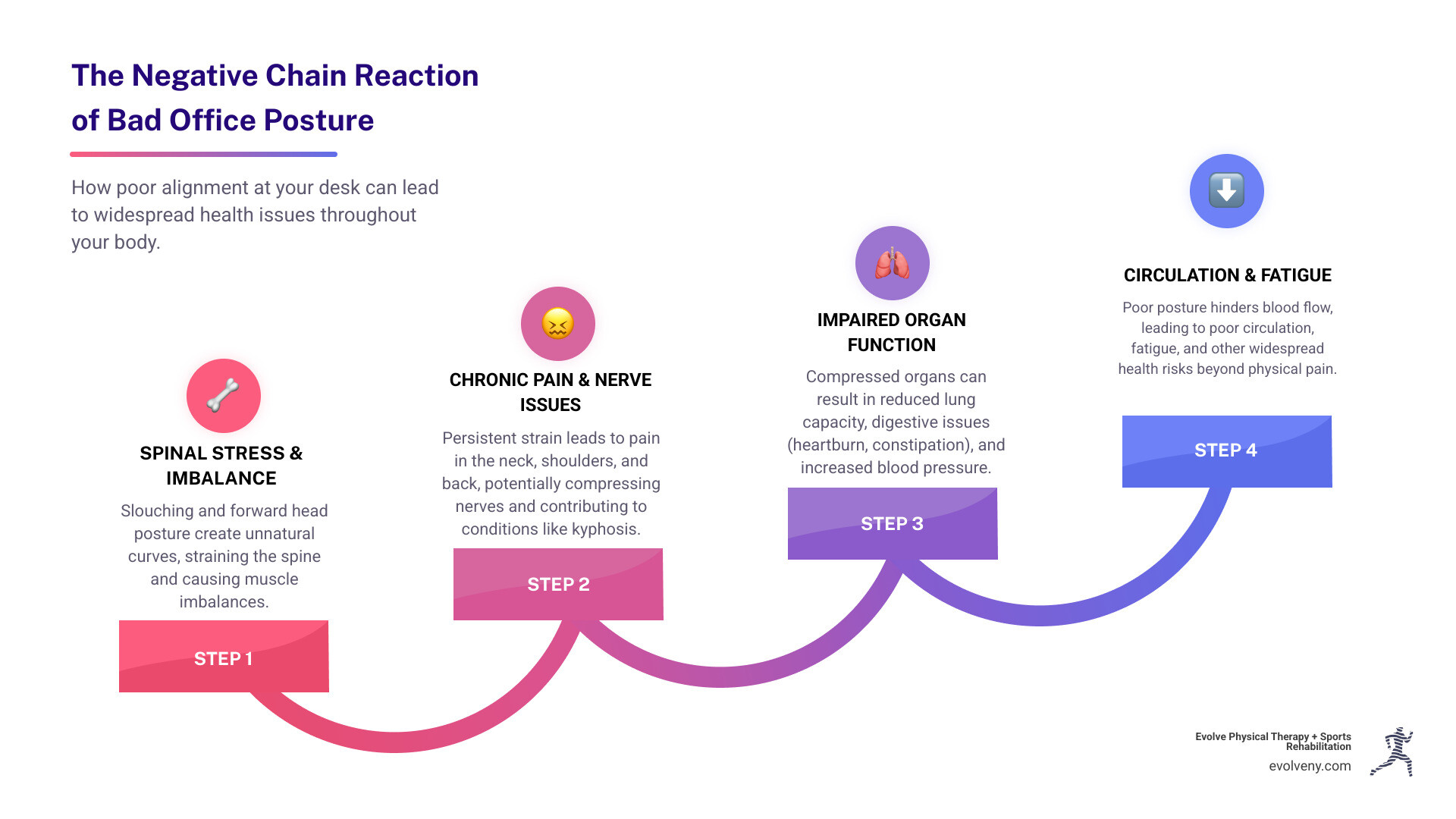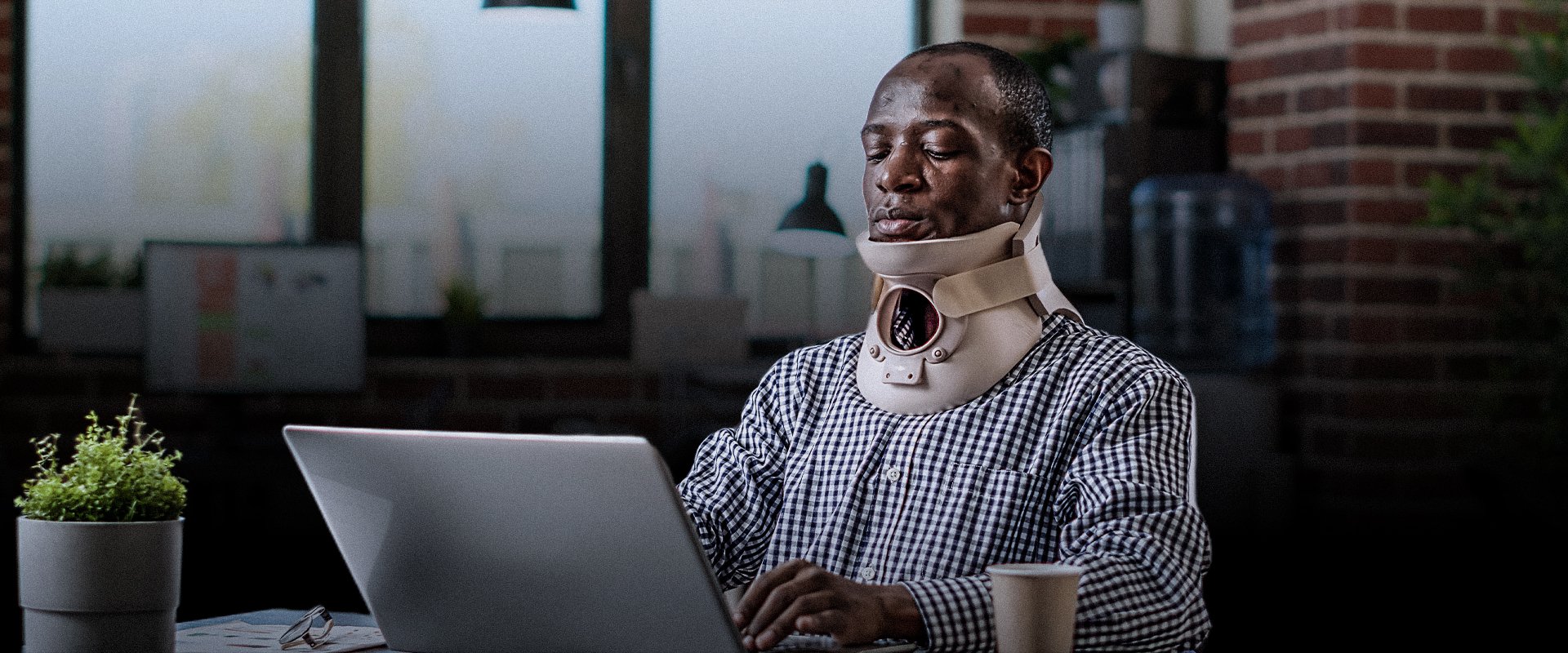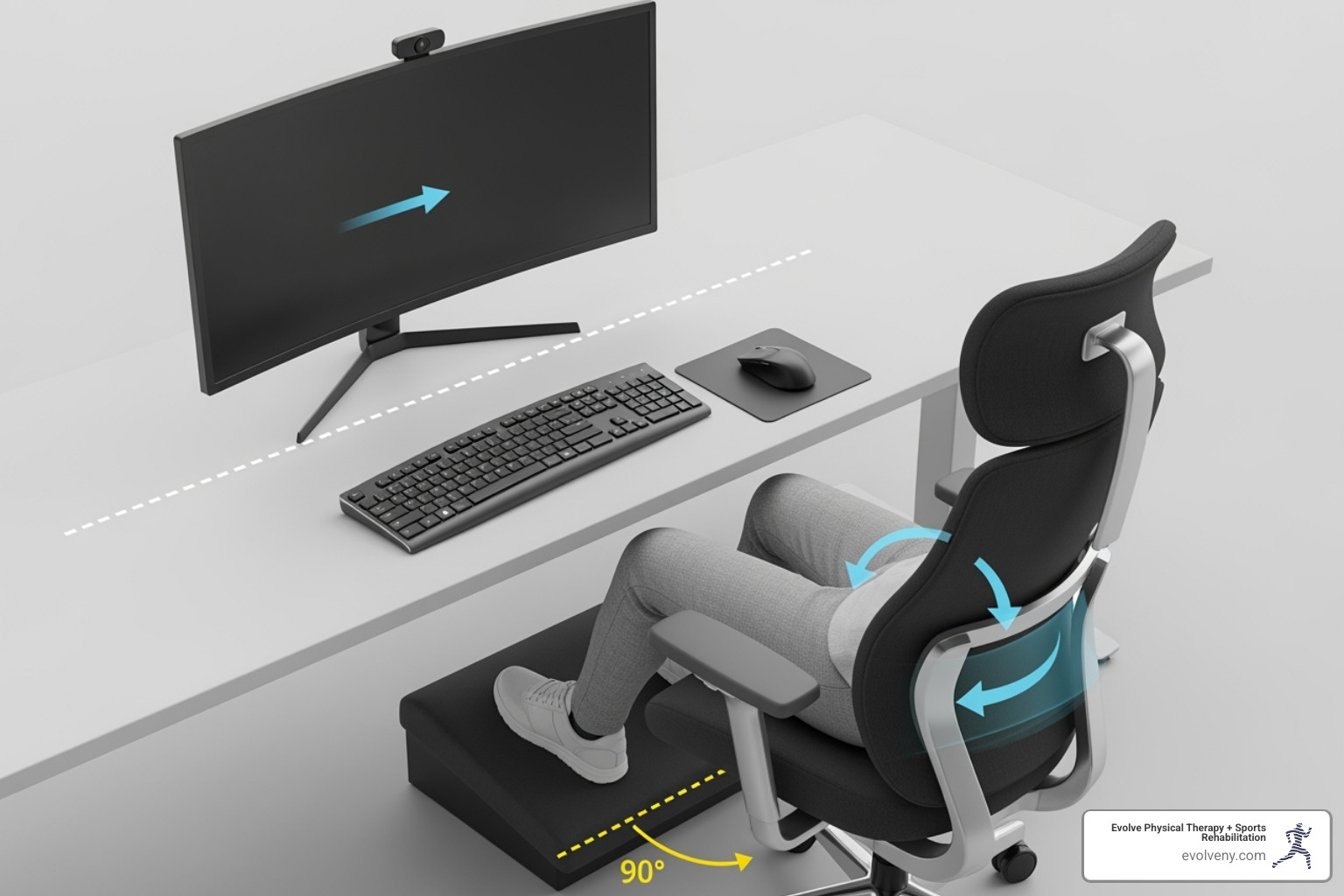Straighten Up! Why Bad Office Posture is a Pain in the Neck
Why Your Office Posture Matters
If you're spending hours at a desk, chances are you've experienced the effects of bad office posture. It's more than just feeling a little stiff. Over time, poor posture can lead to real health problems.
Here’s a quick look at how bad office posture can affect your health:
- Persistent Pain: Chronic discomfort in your back, neck, and shoulders.
- Muscle Strain & Fatigue: Muscles work harder to support your body, leading to tiredness and aches.
- Reduced Lung Capacity: Slouching can compress your lungs, making breathing less efficient.
- Digestive Issues: Poor posture can put pressure on internal organs, potentially causing heartburn or constipation.
- Headaches: Often linked to neck and upper back tension from poor alignment.
- Circulation Problems: Prolonged static positions can hinder blood flow.
As Lou Ezrick, founder of Evolve Physical Therapy, I've spent nearly two decades helping patients overcome the challenges of chronic pain and mobility issues often linked to bad office posture. My experience in rehabilitation has shown me how critical proper alignment and movement are for overall well-being.

The Hidden Dangers of Your Desk Job
When we talk about bad office posture, many of us picture someone hunched over their keyboard, looking a bit like a question mark. While that image might bring a chuckle, it actually points to a serious truth about the silent toll our desk jobs can take on our bodies. Prolonged slouching and that all-too-common forward head posture (you might know it as "tech neck") create immense spinal stress. Instead of our spine acting as a strong, aligned pillar, it becomes a strained, curved line. This leads to a sneaky problem called muscle imbalance, where some muscles get stretched out and weak, while others become tight and overworked.
But here’s where it gets really interesting – and a little surprising! The effects of poor posture go much deeper than just a sore back or stiff neck. Did you know your posture can actually impact your internal organs? When you slouch, you can compress your lungs, leading to reduced lung capacity. This means your body might not be getting as much oxygen as it needs, leaving you feeling tired. Similarly, poor posture can put pressure on your abdominal organs. This can slow things down internally and contribute to issues like constipation or even heartburn by pushing stomach acid back up. These are just a few of the surprising risks you might not have considered! You can dive deeper into these unexpected effects here: 3 surprising risks of poor posture - Harvard Health.
Beyond these internal impacts, spending long hours with bad office posture can lead to increased blood pressure and poor circulation, especially in your legs. Our bodies are truly designed to move, not to stay stuck in one position for hours on end. It's a bit alarming to think that less than half of Americans are even concerned about the effects of poor posture! We're here to help change that statistic. You can learn more about the broader health risks of sitting for too long here: More on the health risks of sitting.
Why bad office posture is more than just a pain
It’s easy to shrug off those nagging aches and pains as just part of a busy workday or getting a little older. But with bad office posture, those minor discomforts are often important warning signs of bigger problems brewing beneath the surface. Our spinal discs, which act like tiny shock absorbers between our backbones, are especially vulnerable. Slouching puts uneven pressure on these discs, which can eventually lead to increased pressure and even disc herniation. This poor alignment can also cause ligament strain as the supportive ligaments of your spine are stretched beyond their healthy limits.
When your spine is out of alignment, it can also lead to nerve compression. This might feel like tingling, numbness, or even a sharp pain radiating down an arm or leg, similar to sciatica. And those muscles that are supposed to hold you upright? They become fatigued from working overtime, or they get weak from not being properly engaged. This constant muscle fatigue can make even simple movements feel like a huge effort.
If left uncorrected, chronic bad office posture can contribute to long-term conditions. One common one is kyphosis, an excessive outward curve of the upper back that sometimes looks like a "dowager's hump." At Evolve Physical Therapy, we have specialized programs designed to help improve conditions like this: Physical Therapy for Dowager's Hump. The impact isn't just physical, though! Poor posture can also have surprising psychological effects. Studies suggest that standing tall can actually boost your self-confidence, while a slumped posture might contribute to feelings of reduced confidence, or even anxiety and depression. So, standing up straight isn't just great for your body – it’s great for your mind too!
How to Identify and Correct Common Bad Office Posture Habits

To improve our posture, we first need to understand what it actually looks like. It's easy to fall into habits without realizing their impact on our bodies. Self-assessment is the first step towards making positive changes.
A simple way to check your standing posture is with the "wall test". Just stand with your back, head, and heels gently touching a wall. Ideally, your head, shoulder blades, and buttocks should all touch, with only a small, natural gap at your lower back. If there's a big gap, or if parts of your body don't touch at all, it can be a clear sign of misalignment.
For sitting, a quick "posture checklist" can be super helpful. Are your feet flat on the floor? Are your knees about hip level? Is your back feeling supported? Is your computer monitor at eye level? Asking these simple questions brings a sense of mindfulness to your daily routine. The goal here isn't to be "perfect," but to become aware. By gently paying attention to how we sit and stand, we can begin the process of habit reversal, guiding our bodies back to a more neutral and supportive alignment.
Identifying your specific bad office posture
Let's explore some of the most common habits that contribute to bad office posture. Chances are, you might recognize a few of these in yourself!
One big culprit is Tech Neck (Forward Head). This happens when your head juts forward, often because you're looking down at a screen. It puts an incredible amount of strain on your neck and upper back. Did you know your head weighs about 12 pounds? For every inch it moves forward, the strain on your neck muscles actually doubles!
Then there's Slouching (Curved Spine). Instead of sitting tall with the natural curves of your spine, you round your back, which puts uneven pressure on those important spinal discs. It's like squishing a sponge on one side.
Another common one is Crossed Legs. While it might feel comfortable, crossing your legs can throw your hips, pelvis, and spine out of alignment. Over time, this can lead to muscle imbalances and even impact your circulation. Similarly, Leaning to One Side creates an uneven weight distribution, straining muscles and ligaments on just one side of your body.
If you often find yourself holding your phone between your ear and shoulder, that's called Cradling your Phone. This habit puts extreme stress on your neck and shoulder muscles, leading to tightness and pain. A little tip: using a headset can reduce muscle tension by up to 41%, making it a much healthier alternative! And finally, there are Hunched Shoulders, often a result of tension, stress, or reaching too far for your keyboard or mouse. This pulls your shoulders up and forward, straining your upper back and neck.
At Evolve Physical Therapy, we regularly help our patients understand and correct these common habits. For more detailed insights, be sure to check out our guide on Correct Computer Posture.
Quick fixes for immediate relief
Sometimes, you need a little immediate relief while you're working on those long-term changes. Here are some quick fixes you can try right at your desk to help combat bad office posture:
First up, Chin Tucks. Gently pull your chin straight back, as if you're trying to make a double chin, to bring your head directly over your shoulders. Hold for a few seconds. This is excellent for counteracting "tech neck." Next, try some Shoulder Rolls. Roll your shoulders up towards your ears, then back, and finally down. This helps release tension and encourages them to relax into a natural position.
For your lower back, try Pelvic Tilts. While seated, gently rock your pelvis forward and backward. This helps you find a neutral spine position and gently engages your core muscles. If your office chair isn't offering enough support, a simple Lumbar Support Towel Roll can be a lifesaver. Just roll up a small towel and place it horizontally in the small of your back to help maintain that natural curve of your lower spine.
A super easy one: simply Consciously Uncross Your Legs! Keep both feet flat on the floor or a footrest. And as mentioned before, if you're on the phone a lot, investing in a hands-free Headset is a game-changer for preventing neck and shoulder strain.
These small adjustments might seem minor, but they can make a significant difference in how you feel throughout your workday. For even more insights into common work desk mistakes and how to fix them, we recommend checking out this helpful resource: 3 Work Desk Mistakes That Can Lead to Bad Posture & Pain.
Your Ergonomic Blueprint: Building a Pain-Free Workspace

Does "ergonomics" sound like a complicated science? Well, it is a science, but it's really all about making your workspace fit you. Imagine designing your desk and chair so they support your body perfectly, instead of you trying to awkwardly fit into them. That's ergonomics in a nutshell! It's about setting things up to lessen physical strain, boost your comfort, and even help you get more done.
The main goal is to help you find a "neutral posture." This is where your joints line up nicely, putting less stress on your tissues and letting your muscles work without struggling. And here's the warm, human truth: there's no single "perfect" ergonomic setup that works for everyone. We're all built differently! Our heights, arm lengths, and even our past injuries mean that a truly effective setup needs to be customized just for you.
Putting a little time and effort into your workspace now can save you a lot of aches and pains later, especially when it comes to preventing bad office posture. We believe in this so much at Evolve Physical Therapy + Sports Rehabilitation that we offer special ergonomic physical therapy to help you get it just right. Want to learn more about how we can help? Check out our insights on Ergonomics and Physical Therapy.
The Ergonomic Chair Setup
Your office chair is truly the heart of your ergonomic kingdom! Getting it right makes a huge difference. Let's walk through how to set it up for maximum comfort and support:
First, make sure your feet are flat on the floor or a sturdy footrest. No dangling or crossing legs! Then, check your knees – they should be at roughly a 90-degree angle, or even a little lower than your hips. This helps keep your hips happy and aligned.
Next up is your lower back. Your chair should provide good lumbar support for the natural inward curve of your spine. If your chair doesn't have it built-in, a small pillow or even a rolled-up towel can do the trick. For seat depth, you should have about two to three finger-widths (about 2-4 inches) between the edge of your seat and the back of your knees. This prevents pressure that can mess with your circulation.
Don't forget the armrests! Adjust them so your armrests are at the right height, allowing your arms to rest gently with your elbows close to your body, forming about a 90-degree angle. Your shoulders should feel relaxed, not hunched up. Lastly, while sitting perfectly upright at 90 degrees might seem like the "correct" way, studies actually suggest a slight reclining angle (100-135 degrees) is better for taking pressure off your spinal discs. Play around to find what feels best for you.
Getting your chair just right is a game-changer. We've got an even more detailed guide if you want to dive deeper into the science of sitting: The Best Ergonomic Way to Sit at a Desk.
Monitor, Desk, and Keyboard Placement
Once your chair is perfectly dialed in, it's time to fine-tune the rest of your workspace. Think of it as creating a custom cockpit just for you!
Your monitor should be positioned directly in front of you, with the monitor at eye level. The top of the screen should be at or just below your eye line. This stops you from craning your neck up or down all day. If you wear bifocals, you might need to lower it just a touch more. And how far away should it be? About an arm's length distance (20-40 inches) is usually ideal. This helps reduce eye strain and keeps your head in a good, neutral spot.
Now for your keyboard and mouse. Your keyboard should be at elbow height, meaning your forearms are parallel to the floor and your elbows are at roughly a 90-degree angle when your hands are on the keyboard. When you're typing, aim for neutral wrists – keep them straight, not bent up or down. A little tip: if your keyboard has little feet, consider pushing them in. A slight negative keyboard tilt (where the keyboard slopes away from you) can actually be more comfortable for your wrists. Finally, keep your mouse placement close to your keyboard, easy to reach, so you're not stretching or twisting your arm. Try to use your whole arm to move the mouse, rather than just flicking your wrist.
These small adjustments, combined with a properly set up chair, are your personal blueprint for a more comfortable, pain-free workday. For even more tips on optimizing your desk, take a look at our guide on Ideal Desk Posture.
Beyond the Desk: Lifestyle Habits for a Healthier Spine
Alright, we've talked a lot about setting up your workspace just right. But here’s a secret: a perfect ergonomic setup is only half the battle! Our bodies are made for movement, and even the fanciest chair won't fully protect you from the effects of sitting still too long. That's why we always say, "movement is medicine." Getting up, stretching, and moving around during your day are super important for a happy, healthy spine.
Think of it this way: your body needs strong support, and that comes from your core strength. Your core muscles—your abs, lower back, and glutes—work like a natural corset, keeping your spine aligned and stable. If these muscles are weak, other parts of your body have to pick up the slack, which can lead to strain and pain. And don't forget flexibility! Tight muscles, especially in your hips, hamstrings, and chest, can pull your body out of alignment, making bad office posture worse. Last but not least, hydration is a quiet superhero. The discs in your spine need water to stay plump and do their job as shock absorbers, so keep that water bottle handy! Want to dive deeper into why good posture is so vital for your overall health? Check out this great resource: Proper posture is important for good health.
Integrating Movement and Exercise

Even with the best desk setup, staying put for hours is a no-go for your body. It truly craves variety and movement. So, how can you sneak more activity into your workday without leaving your office?
If you have a standing desk, aim for a smart sit-to-stand ratio. We suggest alternating between sitting and standing frequently, maybe a 1:1 or 3:1 ratio in favor of standing. The key is to switch positions often, not just stand for hours. Try using a timer, like the Pomodoro technique, to remind yourself to take short regular breaks. Every 25-30 minutes, stand up and move around for 5 minutes. Grab some water, take a quick stroll, or just stand and stretch.
You don't need a gym membership to get moving during the day. Simple desk exercises can make a huge difference:
- Neck Stretches: Gently tilt your head to one side, aiming your ear towards your shoulder. Feel that stretch? Now switch sides.
- Shoulder Blade Squeezes: Sit up tall, then gently squeeze your shoulder blades together as if you're trying to hold a pencil between them. Hold for a few seconds.
- Chest Stretch: Clasp your hands behind your back and gently lift them away from your body. This helps open up your chest, especially if you tend to hunch.
- Torso Twists: While seated, gently twist your upper body from side to side, keeping your hips stable.
Beyond these quick desk fixes, try to weave core exercises into your routine outside of work. Moves like planks, dead bugs, and bird-dogs are fantastic for building that crucial spinal support. And don't forget dedicated stretching! Focus on areas that get tight from sitting, like your hip flexors and chest. Yoga, for example, is a wonderful way to boost your overall flexibility and body awareness.
Posture Outside the Office
Our posture habits aren't just for the office; they follow us everywhere! What you do when you're not at your desk can have a huge impact on your spine.
First up, your sleep setup. A supportive mattress is absolutely essential for restful sleep and a healthy spine. If you're waking up with aches and pains, your mattress or even your sleeping position could be the culprit. We've got a detailed guide to help you optimize your sleep for spinal health right here: Best Sleeping Positions to Combat Back, Neck, Foot, and Elbow Pain.
Next, master proper lifting technique. Whether you're moving a heavy box or just picking up a pen, always lift with your legs, not your back. Squat down, keep your back straight, and hold the object close to your body as you stand up. For lighter items, try the "golfer's lift": hinge at your hips, extend one leg back for balance, and reach with the opposite arm. It saves your back!
Finally, practice mindful walking posture. Imagine a string gently pulling you up from the top of your head. Keep your head level, your shoulders relaxed and back, and engage your core just a little. Let your arms swing naturally by your sides. Being aware of your posture even when you're out and about can make a big difference in how you feel!
Special Considerations: From Kids to Seeking Professional Help
While we've focused heavily on adult office workers, the issue of bad office posture is becoming a generational concern. With increased screen time for education and entertainment, children and teens are now facing posture-related issues that were once primarily seen in adults. Prevention and proactive care are more important than ever.
Ergonomics for Children and Teens
The statistics are concerning: the prevalence of chronic back pain in children and adolescents is increasing, with 1 in 5 school-age children now experiencing back pain. This is often linked to long hours spent hunched over devices.
- Adjustable Furniture: Just like adults, children need workstations that fit their bodies. Look for adjustable desks and chairs that can grow with them, ensuring their feet are flat, knees are at 90 degrees, and monitors are at eye level.
- Backpack Safety: Heavy or improperly worn backpacks are a major culprit for back pain in kids. Ensure backpacks are the right size, packed with heavier items closest to the back, and that both straps are always used.
- 20-20-20 Rule: Encourage children (and adults!) to follow the 20-20-20 rule: every 20 minutes, look at something 20 feet away for 20 seconds. This helps reduce eye strain and reminds them to shift their posture.
- Parental Role Modeling: Children learn by example. When parents prioritize good posture and movement, children are more likely to adopt these healthy habits themselves.
When to See a Physical Therapist for Bad Office Posture
We understand that you're trying to make changes on your own, and that's fantastic! However, there are times when self-correction simply isn't enough, and professional help is needed. You should consider seeing a physical therapist if you experience any of the following:
- Persistent Pain: If your neck, back, or shoulder pain doesn't resolve within a few days or weeks of making ergonomic adjustments and incorporating movement.
- Numbness or Tingling: These sensations can indicate nerve compression and should be evaluated by a professional.
- Pain that Disrupts Sleep: If your pain is so severe that it's preventing you from getting a good night's rest, it's a clear sign that you need intervention.
- Headaches: Chronic headaches, especially those originating from your neck or base of your skull, can often be linked to poor posture and muscle tension.
- Pain Unresolved by Ergonomic Changes: If you've diligently applied all the ergonomic advice and still feel discomfort, a physical therapist can assess your specific body mechanics and identify underlying issues.
At Evolve Physical Therapy, we specialize in addressing posture-related pain and helping you regain your comfort and mobility. Whether it's persistent neck pain, which can be linked to forward head posture, or lower back discomfort from prolonged sitting, we're here to help. Explore our specialized services for: Physical Therapy for Neck Injuries Brooklyn and Physical Therapy for Lower Back Pain.
Conclusion
Wow, we've covered a lot of ground today, haven't we? From shining a light on the hidden dangers of bad office posture to crafting your ideal ergonomic setup and weaving healthy movement into your daily routine, you now have a comprehensive blueprint for a healthier, happier you.
Think of it as three powerful pillars supporting your well-being: First, awareness – truly understanding how your posture affects you, day in and day out. Second, ergonomics – making your workspace a true ally, not an adversary, by setting it up to support your body's natural alignment. And finally, movement – embracing the incredible power of regular breaks and integrating exercise throughout your day, because a body in motion stays in motion!
It's amazing how even small, consistent changes can create a ripple effect, leading to a huge impact on your overall health and energy levels. This isn't just about fixing a temporary ache; it's about taking proactive control of your health, one mindful posture adjustment and one refreshing stretch at a time. So, let's not let bad office posture be a pain in your neck (or back, or shoulders!) any longer.
At Evolve Physical Therapy + Sports Rehabilitation, we believe in a truly hands-on approach to help you build a stronger, more resilient body. We're passionate about empowering you with the knowledge and tools you need to live a healthier, pain-free life. If you're ready to evolve past posture-related pain, we're here to guide you every step of the way.
Learn how our ergonomic physical therapy in Brooklyn can help you.



